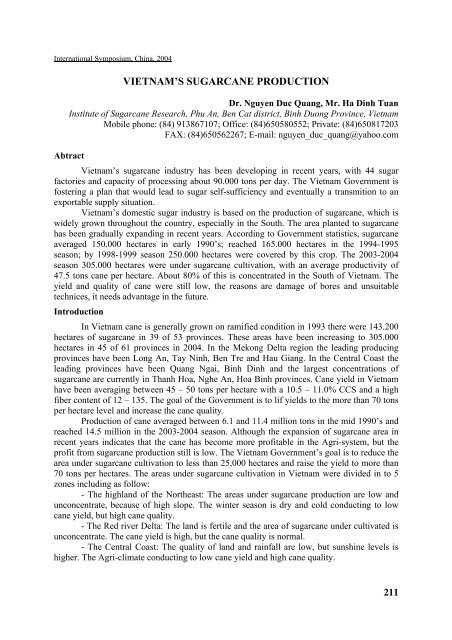TUYEÅN TAÄP
tuyeÃ¥n taäp - CHUYÃN TRANG GIá»I THIá»U CÃC GIá»NG MÃA Tá»T ...
tuyeÃ¥n taäp - CHUYÃN TRANG GIá»I THIá»U CÃC GIá»NG MÃA Tá»T ...
- No tags were found...
You also want an ePaper? Increase the reach of your titles
YUMPU automatically turns print PDFs into web optimized ePapers that Google loves.
International Symposium, China, 2004<br />
VIETNAM’S SUGARCANE PRODUCTION<br />
Dr. Nguyen Duc Quang, Mr. Ha Dinh Tuan<br />
Institute of Sugarcane Research, Phu An, Ben Cat district, Binh Duong Province, Vietnam<br />
Mobile phone: (84) 913867107; Office: (84)650580552; Private: (84)650817203<br />
FAX: (84)650562267; E-mail: nguyen_duc_quang@yahoo.com<br />
Abtract<br />
Vietnam’s sugarcane industry has been developing in recent years, with 44 sugar<br />
factories and capacity of processing about 90.000 tons per day. The Vietnam Government is<br />
fostering a plan that would lead to sugar self-sufficiency and eventually a transmition to an<br />
exportable supply situation.<br />
Vietnam’s domestic sugar industry is based on the production of sugarcane, which is<br />
widely grown throughout the country, especially in the South. The area planted to sugarcane<br />
has been gradually expanding in recent years. According to Government statistics, sugarcane<br />
averaged 150.000 hectares in early 1990’s; reached 165.000 hectares in the 1994-1995<br />
season; by 1998-1999 season 250.000 hectares were covered by this crop. The 2003-2004<br />
season 305.000 hectares were under sugarcane cultivation, with an average productivity of<br />
47.5 tons cane per hectare. About 80% of this is concentrated in the South of Vietnam. The<br />
yield and quality of cane were still low, the reasons are damage of bores and unsuitable<br />
technices, it needs advantage in the future.<br />
Introduction<br />
In Vietnam cane is generally grown on ramified condition in 1993 there were 143.200<br />
hectares of sugarcane in 39 of 53 provinces. These areas have been increasing to 305.000<br />
hectares in 45 of 61 provinces in 2004. In the Mekong Delta region the leading producing<br />
provinces have been Long An, Tay Ninh, Ben Tre and Hau Giang. In the Central Coast the<br />
leading provinces have been Quang Ngai, Binh Dinh and the largest concentrations of<br />
sugarcane are currently in Thanh Hoa, Nghe An, Hoa Binh provinces. Cane yield in Vietnam<br />
have been averaging between 45 – 50 tons per hectare with a 10.5 – 11.0% CCS and a high<br />
fiber content of 12 – 135. The goal of the Government is to lif yields to the more than 70 tons<br />
per hectare level and increase the cane quality.<br />
Production of cane averaged between 6.1 and 11.4 million tons in the mid 1990’s and<br />
reached 14.5 million in the 2003-2004 season. Although the expansion of sugarcane area in<br />
recent years indicates that the cane has become more profitable in the Agri-system, but the<br />
profit from sugarcane production still is low. The Vietnam Government’s goal is to reduce the<br />
area under sugarcane cultivation to less than 25,000 hectares and raise the yield to more than<br />
70 tons per hectares. The areas under sugarcane cultivation in Vietnam were divided in to 5<br />
zones including as follow:<br />
- The highland of the Northeast: The areas under sugarcane production are low and<br />
unconcentrate, because of high slope. The winter season is dry and cold conducting to low<br />
cane yield, but high cane quality.<br />
- The Red river Delta: The land is fertile and the area of sugarcane under cultivated is<br />
unconcentrate. The cane yield is high, but the cane quality is normal.<br />
- The Central Coast: The quality of land and rainfall are low, but sunshine levels is<br />
higher. The Agri-climate conducting to low cane yield and high cane quality.<br />
211






